Abstract
The present article considers the notion of style proposed by Paul Ricœur, and his hermeneutic concepts about interpretation of a text. For such purpose, the chronicle named “The woman that didn’t allow to be punched” by Laura Restrepo, a Colombian journalist and writer. This hermeneutical analysis demonstrates how certain strategies inherent to literature, used by the author, contribute to the objective of denouncing social phenomenon, which transcend the boundaries of our country.
Bal, M. (1998). Teoría de la narrativa. (Una introducción a la narratología). Madrid: Cátedra.
Chillón, A. (2001). El ‘giro lingüístico’ en periodismo y su incidencia en la comunicación periodística”. Cuadernos de información, 14, 24-47.
Egan, L. (2004). Carlos Monsiváis. Cultura y crónica en el México contemporáneo. México: Fondo de Cultura Económica.
Genette, G. (1989). Figuras III. Madrid: Lumen. Genette, G. (1993). Ficción y dicción. Madrid: Lumen.
Genette, G. (2001). Umbrales. México: Siglo XXI.
Piglia, R. (2006). Secreto y narración. Tesis sobre la nouevelle. En E. Becerra (ed.), El arquero inmóvil. Nuevas poéticas sobre el cuento (pp. 187-205). Madrid: Páginas de espuma.
Restrepo, L. (15 de mayo de 2013). La mujer que no dejó que le pegaran. El País, Madrid. Recuperado de: http://cultura.elpais.com/cultura/2013/05/15/actualidad/1368 634460_268105.html
Ricœur, P. (1999). Teoría de la interpretación. México: Siglo XXI.
Ricœur, P. (2006). Del texto a la acción. Ensayos de hermenéutica II. Buenos Aires: Fondo de Cultura Económica.
Rotker, S. (2005). La invención de la crónica. México: Fondo de Cultura Económica, Fundación para un Nuevo Periodismo Iberoamericano.
Villoro, J. (2005). Safari accidental. México: Joaquín Mortiz.
Villoro, J. (2010). Disección de un ornitorrinco. Sala de Prensa, Web Para Profesionales de La Comunicación Iberoamericanos, [Revista electrónica], 129 (6). Recuperado de: http://www.saladeprensa.org/art1040.htm
Weston, A. (1998). Las claves de la argumentación. Barcelona: Ariel.
This journal is registered under a Creative Commons Attribution 4.0 International Public License. Thus, this work may be reproduced, distributed, and publicly shared in digital format, as long as the names of the authors and Pontificia Universidad Javeriana are acknowledged. Others are allowed to quote, adapt, transform, auto-archive, republish, and create based on this material, for any purpose (even commercial ones), provided the authorship is duly acknowledged, a link to the original work is provided, and it is specified if changes have been made. Pontificia Universidad Javeriana does not hold the rights of published works and the authors are solely responsible for the contents of their works; they keep the moral, intellectual, privacy, and publicity rights.
Approving the intervention of the work (review, copy-editing, translation, layout) and the following outreach, are granted through an use license and not through an assignment of rights. This means the journal and Pontificia Universidad Javeriana cannot be held responsible for any ethical malpractice by the authors. As a consequence of the protection granted by the use license, the journal is not required to publish recantations or modify information already published, unless the errata stems from the editorial management process. Publishing contents in this journal does not generate royalties for contributors.


